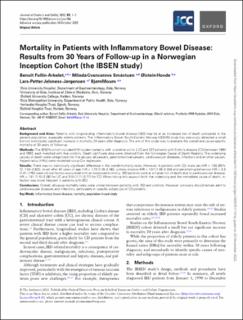| dc.contributor.author | Follin-Arbelet, Benoit | |
| dc.contributor.author | Småstuen, Milada Cvancarova | |
| dc.contributor.author | Hovde, Øistein | |
| dc.contributor.author | Jelsness-Jørgensen, Lars-Petter | |
| dc.contributor.author | Moum, Bjørn Allan | |
| dc.date.accessioned | 2023-01-20T10:30:46Z | |
| dc.date.available | 2023-01-20T10:30:46Z | |
| dc.date.created | 2022-11-23T13:48:31Z | |
| dc.date.issued | 2022 | |
| dc.identifier.citation | Journal of Crohn's and Colitis. 2022, Artikkel jjac156. | en_US |
| dc.identifier.issn | 1873-9946 | |
| dc.identifier.uri | https://hdl.handle.net/11250/3044913 | |
| dc.description.abstract | Background and Aims: Patients with longstanding inflammatory bowel disease [IBD] may be at an increased risk of death compared to the general population, especially elderly patients. The Inflammatory Bowel South-Eastern Norway [IBSEN] study has previously detected a small but not statistically significant increase in mortality 20 years after diagnosis. The aim of this study was to evaluate the overall and cause-specific mortality at 30 years of follow-up.
Methods: The IBSEN cohort included 519 incident patients with ulcerative colitis [UC] and 237 patients with Crohn’s disease [CD] between 1990 and 1993, each matched with five controls. Death certificate data were obtained from the Norwegian Cause of Death Registry. The underlying causes of death were categorized into five groups: all cancers, gastrointestinal cancers, cardiovascular diseases, infections and all other causes. Hazard ratios [HRs] were modelled using Cox regression.
Results: There was no statistically significant difference in the overall mortality rates. However, in patients with CD, male sex (HR = 1.65 [95% CI: 1.04–2.62]), onset after 40 years of age (HR = 1.72 [1.19–2.48]), colonic disease (HR = 1.57 [1.05–2.35]) and penetrating behaviour (HR = 3.3 [1.41–7.76]) were clinical factors associated with an increased mortality. IBD patients were at a higher risk of death due to cardiovascular disease: HR = 1.51 [1.10–2.08] for UC and 2.04 [1.11–3.77] for CD. When taking into account both the underlying and the immediate cause of death, infection was more frequent in patients with IBD.
Conclusions: Overall, all-cause mortality rates were similar between patients with IBD and controls. However, clinicians should remain alert to cardiovascular diseases and infections, particularly in specific subgroups of CD patients. | en_US |
| dc.language.iso | eng | en_US |
| dc.publisher | Oxford University Press | en_US |
| dc.subject | inflammatory bowel disease | en_US |
| dc.subject | mortality | en_US |
| dc.subject | population-based study | en_US |
| dc.title | Mortality in patients with Inflammatory Bowel Disease: Results from 30 years of follow-up in a Norwegian inception cohort (the IBSEN study) | en_US |
| dc.type | Peer reviewed | en_US |
| dc.type | Journal article | en_US |
| dc.description.version | publishedVersion | en_US |
| dc.rights.holder | © The Author(s) 2022. | en_US |
| dc.subject.nsi | VDP::Medisinske Fag: 700::Klinisk medisinske fag: 750::Gasteroenterologi: 773 | en_US |
| dc.source.journal | Journal of Crohn's and Colitis | en_US |
| dc.identifier.doi | https://doi.org/10.1093/ecco-jcc/jjac156 | |
| dc.identifier.cristin | 2079287 | |
| dc.source.articlenumber | jjac156 | en_US |
| cristin.ispublished | true | |
| cristin.fulltext | original | |
| cristin.qualitycode | 2 | |
